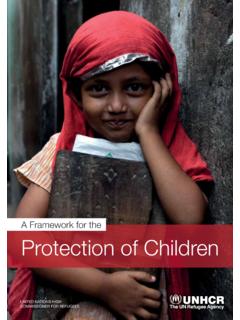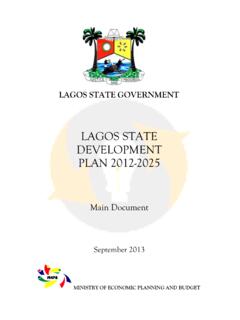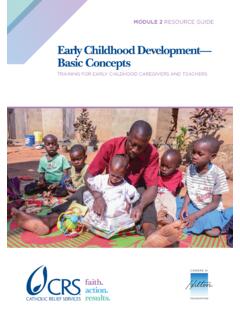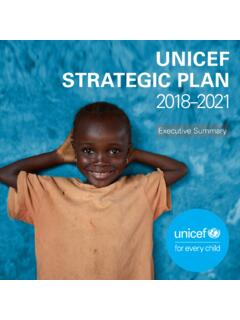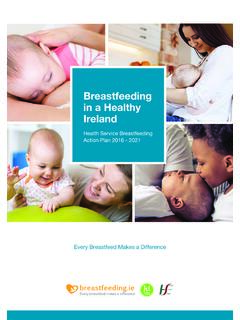Transcription of IMPROVING EARLY CHILDHOOD DEVELOPMENT
1 SUMMARYIMPROVING EARLY CHILDHOOD DEVELOPMENT : WHO GuidelineAttachmentAn emotional bond between an infant and one or more adults. The infant will approach these individuals in times of distress, particularly during the phase of infant DEVELOPMENT when the presence of strangers induces anxiety. In addition, the infant is distressed if separated from attachment affective disorder characterized by a sense of inadequacy, feelings of despondency or hopelessness, a decrease in activity and/or reactivity, pessimism, sadness, irritability, changes in appetite and sleep patterns, and poor potentialAbility to think, learn, remember, relate and articulate ideas appropriate to age and level of maturity.
2 EARLY CHILDHOOD developmentRefers to the cognitive, physical, language, motor, social and emotional DEVELOPMENT between 0 - 8 years of learningAny opportunity for the baby, toddler or child to interact with a person, place or object in their environment, recognizing that every interaction (positive or negative, or absence of an interaction) is contributing to the child s brain DEVELOPMENT and laying the foundation for later learning. (Child) MaltreatmentThe abuse and neglect of children under 18 years of age. It includes all types of physical and/or emotional ill-treatment, sexual abuse, neglect, negligence and commercial or other exploitation, which results in actual or potential harm to the child s health, survival, DEVELOPMENT or dignity in the context of a relationship of responsibility, trust or bondingA process that includes the emotional tie of a mother to her infant.
3 Occurring in the first week or year of an infant s life and that is influenced by signals and cues from the child as well as the maternal-driven careCharacterized by a caregiving environment that is sensitive to children s health and nutritional needs, responsive, emotionally supportive, and developmentally stimulating and appropriate, with opportunities for play and exploration and protection from as being for its own sake (without a specific goal), voluntary, a special activity (out of the ordinary), enjoyed by participants, governed by rules (implicit or explicit) and imaginative.
4 It can be solitary or social, and with or without objects. Young children acquire and consolidate developmental skills through playful interactions with people and parentingIncorporates anticipatory guidance for safety, education, DEVELOPMENT and the establishment of a caring and understanding relationship with one s child. Parenting is not limited to biological parents, but extends to guardians or caregivers providing consistent care for the caregivingIncorporates anticipatory guidance for safety, education, DEVELOPMENT and the establishment of a caring and understanding relationship with one s child.
5 Parenting is not limited to biological parents, but extends to guardians or caregivers providing consistent care for the capacity of the caregiver to respond contingently and appropriately to the infant s information received from interactions with people and environmental variability that engages a young child s attention and provides information; examples include talking, smiling, pointing, enabling and demonstrating, with or without OF TERMSB1 IMPROVING EARLY CHILDHOOD DEVELOPMENT : WHO guideline SummaryEnabling young children to achieve their full developmental potential is a human right and a critical requisite for sustainable DEVELOPMENT .
6 Evidence in the Lancet series Advancing EARLY CHILDHOOD DEVELOPMENT : from science to scale (Lancet, 2017) highlights the profound benefits of investing in EARLY CHILDHOOD DEVELOPMENT (ECD) for learning, productivity, health and social cohesion along the life course. The series highlighted the critical importance of the EARLY years and coined the term nurturing care as a central tenet of what is required to achieve optimal DEVELOPMENT , namely health, nutrition, security and safety, responsive caregiving and opportunities for EARLY learning. The Nurturing Care framework (WHO, unicef & World Bank Group, 2018) was launched at the time of the World Health Assembly in 2018 to provide a roadmap for action.
7 The framework builds on state-of-the-art evidence about how child DEVELOPMENT outcomes are influenced and how they can be improved by policies and interventions. Nurturing care is characterized by a stable environment that promotes health and optimal nutrition, protects children from threats, and gives them opportunities for EARLY learning, through affectionate interactions and relationships (Figure). It describes how a whole-of-government and a whole-of-society approach can promote nurturing care for young children and outlines guiding principles, strategic actions and ways of monitoring progress.
8 The framework focuses on the period from pregnancy to age 3 within a life-course approach and addresses all relevant sectors, but with a spotlight on the health sector. ECD refers to the process of cognitive, physical, language, temperament, socioemotional and motor DEVELOPMENT of children that starts at the time of conception until 8 years of age. The earliest years are especially important, being the time when the brain develops rapidly; it is therefore a critical period for the fetus and child to receive nurturing care. It is also the period when the fetus and child are most sensitive to interventions (Lancet, 2017).
9 Being at the forefront of providing nurturing care, parents and other primary caregivers need to be supported through policies, information and services in order to have knowledge, skills, time and material resources for appropriate child care. Figure: Components of nurturing careGiven the critical importance of enabling children to make the best start in life, the health sector has an important role and responsibility to support nurturing care. Many interventions for reproductive, maternal, newborn and child health (including for nutrition, mental health and HIV prevention and care) have a direct impact on ECD.
10 Moreover, the health sector has access to families and caregivers during this period and therefore has specific opportunities. Until now, WHO has not had guidelines specifically on interventions for IMPROVING ECD. Existing WHO guidelines related to neonatal care; infant and young child nutrition; environmental health; prevention and treatment of CHILDHOOD illnesses; violence and injury prevention; mental health; prevention of noncommunicable diseases; and support for children with developmental difficulties or disabilities, refer to the importance of respective interventions for ECD.










